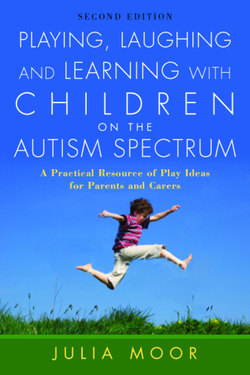Читать книгу Playing, Laughing and Learning with Children on the Autism Spectrum - Julia Moor - Страница 21
На сайте Литреса книга снята с продажи.
Playing the magnetic fishing game
ОглавлениеThe goal – to play ‘turn-taking’ with a magnetic fishing game.
The materials – magnetic fishing games, which are available in many toy shops. Do remember to get an easy-to-handle one or, alternatively, make a simple version yourself by doing the following: Cut a piece of fabric or card into a pond shape. Make six cardboard fish with paper clips attached to their mouths. Make a rod from a piece of dowel and string, and attach a strong magnet to the end of the string.
The tasks –
To lift the rod up slowly with the fish on, after the parent has steered the magnet to the fish.
To attach the magnet himself with his hands and then lift the rod clear.
To attach the magnet by dangling it over the fish.
To ‘turn take’ with two fish.
To ‘turn take’ with six fish.
To add picture cards for him to label on the reverse side of the fish, or to put numbers on the reverse side. Whoever has the highest number, wins.
Even though this is highly structured in some ways, there are no set rules. Some children might get the hang of an activity very quickly and skip straight through all the tasks; others might need extra help from you in motivating them to look at the activity and attempt the first task. Accomplishing each task can be seen as a separate play session – a general ‘fishing game’ picture prompt can be used for each session. The first example session might go as follows:
The materials are set up. Mum and Adam collect the fishing game picture card off his diary board (see later section, ‘Structuring the Day’). The next picture card is of Adam’s reward/reinforcer – listening to music.
| Mum: | Now it’s time to play ‘fishing’. Let’s get the card, Adam. (Adam ignores her and picks up the music card.) |
| Mum: | Yes Adam…after the fishing game we’ll play music. (Adam still resists a little.) |
| Mum: | I can see…a yellow fish and a rod! (Mum takes the fish and pretends to make it swim. She then picks it up and drops it, saying ‘it’s got away…come back naughty fish!’…she plays as if for her own pleasure.) (Adam stands on the fish.) |
| Mum: | Well done, you caught it…it’s got your toes! (Mum makes the fish tickle Adam’s toes.) (Adam sits down.) (Mum puts the rod in his hands and closes her hand around his. They lift the fish out together with a ‘One two three…wheee!’ Mum puts the magnet on the fish and lays the rod on the floor. Adam stands up and starts to walk away.) |
| Mum: | It’s ready to go ‘One two three Wheee!’ Adam – (Mum points to the rod) Adam do ‘One two three wheee’, then listen to music. (Mum physically guides his hand to the rod.) (Adam finally crouches and lifts the rod – Mum touches his elbow, saying ‘s..l..o..w..l..y’) |
| Mum: | Yes, well done! – Adam did it! Let’s listen to music. |
The next two or three play sessions could be spent trying to make simply lifting up the fish fun and motivating so that completing the play activity is not simply a means to reaching the reward. Be as silly and creative as you can be:
Vary the ‘fish’ – draw colours or stick pictures on them.
Stick a chocolate button or Smartie eye on the fish with masking tape folded over on itself to make it double sided (you might try sticky tape, but make it less sticky by pressing it onto your clothes a few times first).
Make the fish ‘do’ things that may make your child laugh.
This is where parents and carers really have to work hard. Non-autistic children simply don’t need to be taught step-by-step that this is a fun activity – understanding the meaning of the game and what it represents just happens, and any additional fun is just that…an extra bonus. Children with autism will struggle to understand: ‘Why do I need to do this thing?’ Your job is to teach your child that playing, and interaction, are fun!
On the basis of this example, any activity (not necessarily just play) can be broken down into a number of tasks that can be taught separately. In the same way that back chaining can be used to complete jigsaws (your child places in the last piece, then the last two pieces, etc.), it can also be used for any play task. Your child’s first play session is completing the last task after you have guided him through the rest, i.e. he lifts the rod after you have attached it to the fish and put the rod into his hand. After he understands and can do each stage, take him back one more step, i.e. next stage he attaches the fish to the magnet, then next stage he dangles the rod over the fish to catch it, etc.
Analysing play activities in this way takes some practice, but very quickly becomes simply your way of playing with your own child. You may already have been doing this to an extent without even realizing exactly what you were doing!
